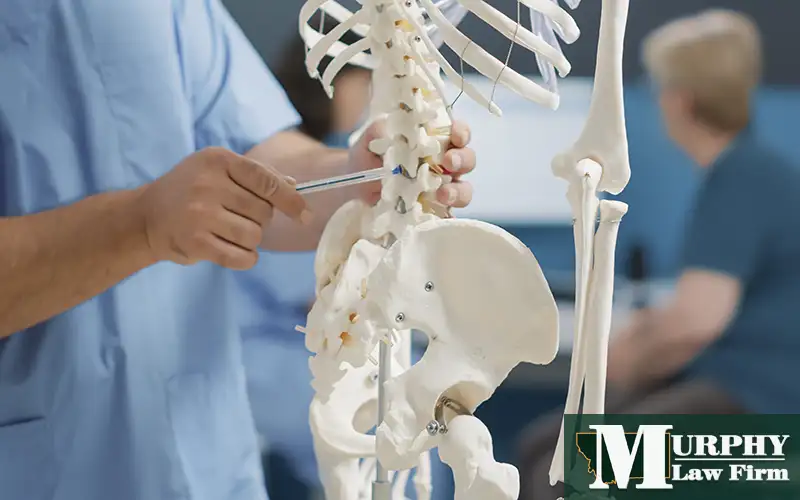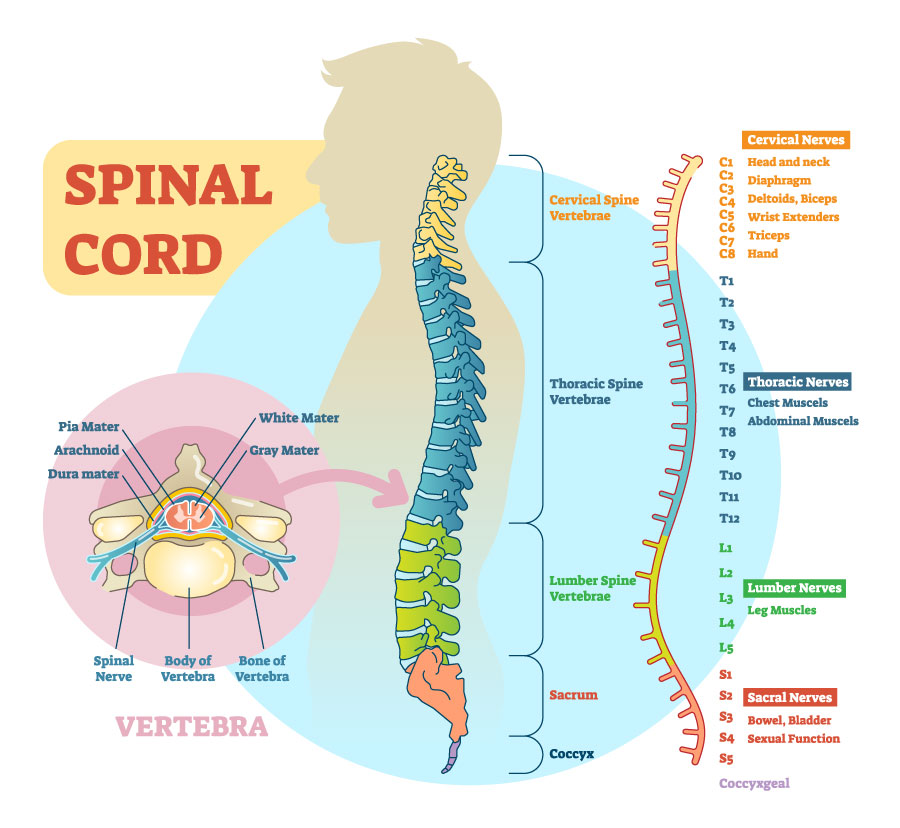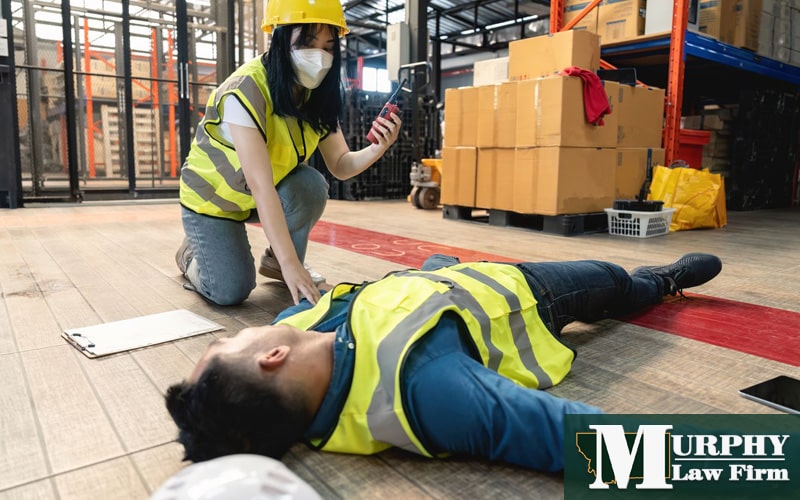
Learn about your right to compensation after a spinal cord injury resulting in paralysis
Anyone who’s suffered a severe back injury at work involving the spinal cord knows it can be a life-altering injury with far-reaching implications, not just for your health but also for your ability to earn a living.
Workers’ compensation can offer some relief, but navigating the system and negotiating with insurance companies can be complex and frustrating. Fortunately, you don’t face this journey alone.
At Murphy Law Firm, our knowledgeable work injury attorneys can help you get the compensation you need to cover your medical bills, rehabilitation costs and other necessary expenses.
Your future well-being depends on the legal choices you make today, so the sooner you act, the better.
Let us focus on fighting for your rights, so you can focus on your recovery.
How common are spinal cord injuries?
According to a study published in the National Library of Medicine, acute spinal cord injuries (caused by trauma to the spinal cord) affect about 54 out of every 1 million people in the U.S. each year. With a population in 2023 of about 340 million people, that means that every year, approximately 18,360 people experience some form of traumatic injury to their spinal cords.
What is the spinal cord, and what does it do?
The spinal cord is a long, tube-shaped structure that contains nervous tissue, which starts at the base of the brain and runs down the lower back. Its purpose is to transmit information between the brain and the rest of the body to facilitate both movement and sensory functions.
The spinal cord is protected by the vertebral column, which consists of individual vertebrae stacked on top of each other. The cord itself is also covered by layers of protective membranes called meninges.
What is a spinal cord injury?
A spinal cord injury refers to damage to the spinal cord that results in a loss of function, such as mobility or sensation. The spinal cord is a critical component of the central nervous system, and its injury can have severe, life-altering consequences. The severity and location of the injury determine the extent of the dysfunction, which can range from mild numbness or weakness to full paralysis.
What are the types of spinal cord injuries?
Spinal injuries are broadly categorized into 2 types: complete and incomplete.
- Complete spinal cord injury. In a complete spinal cord injury, the damage to the spinal cord is so severe that it eliminates all sensory and motor functions below the level of the injury. This means there is no sensation or voluntary muscle movement on either side of the body below the point of injury. Complete injuries often result in either paraplegia (loss of function in the legs and lower body) or tetraplegia (also known as quadriplegia, loss of function in both the arms and legs).
- Incomplete spinal cord injury. An incomplete spinal cord injury is characterized by some remaining function below the level of the injury. People with an incomplete injury may still have some degree of sensation and might also retain some muscle movement. The level of function varies widely and depends on the severity and location of the injury. Some individuals might be able to walk with assistance, while others might have significant paralysis despite the injury being classified as incomplete.
Both types of injuries can occur at various points along the spinal cord, from the cervical vertebrae in the neck down to the sacral region in the lower back.
How does the level of spinal cord injury impact movement and body functions?
Spinal cord injuries can be further categorized based on the level of the vertebrae affected, with higher injuries generally causing more severe dysfunction.
- High-cervical nerves (C1-C4). Also known as quadriplegia, these are the most severe injuries, leading to paralysis in arms, hands, trunk and legs. Patients require complete assistance for daily activities and 24-hour care and have no bladder or bowel control. Breathing may also be impaired.
- Low-cervical nerves (C5-C8). Injuries at this level vary but generally allow some arm and hand movement. The affected individuals may need assistive devices for daily activities and may have limited or no control over their bowel or bladder.
- Thoracic nerves (T1-T12). These injuries typically result in paraplegia, affecting the trunk and legs but leaving arm and hand function intact. Individuals can often use a manual wheelchair and may be able to drive a modified car. They may have limited or no control over their bowel or bladder.
- Lumbar nerves (L1-L5). These injuries usually result in some loss of function in the hips and legs but may allow for walking with braces. Bowel or bladder control is also typically compromised.
- Sacral nerves (S1-S5). Injuries at this level also result in some loss of function in the hips and legs, but walking is usually possible. Bowel or bladder control may be affected but can often be managed with special equipment.

Each level of injury has its own set of challenges and possible outcomes, ranging from complete assistance to relative independence. The treatment and rehabilitation needs for these injuries can differ significantly, requiring a multidisciplinary approach involving medical, physical and psychological therapies.
What are the top causes of spinal cord and back injuries at work?
Motor vehicle accidents are perhaps the most frequent cause of spinal cord injuries in the workplace, particularly in sectors that require extensive driving or the operation of heavy machinery.
Other common causes of spine injuries on the job include the following:
- Falls. Slips, trips and falls, especially from heights like ladders, scaffolding or unguarded platforms, are a significant cause of spinal cord injuries at work. Uneven flooring and obstacles are other common hazards that lead to these accidents.
- Heavy lifting. Incorrect manual handling of heavy objects can lead to spinal cord injuries, especially in industries like construction, farming, warehousing and manufacturing.
- Falling objects. In some job settings, workers are at risk from objects falling from above, which can result in severe spinal cord damage if the objects are heavy or fall from a significant height.
- Struck by/against events. Severe spinal cord injuries can occur when a worker is struck by or against an object, such as machinery or a moving vehicle.
- Machinery accidents. Workers who operate or work around heavy machinery like forklifts are at risk for spinal cord injuries due to equipment malfunctions or operational errors.
- Confined spaces. Working in confined or awkward positions can put stress on the spinal cord and increase the risk of injury, especially in occupations like mining or tunnel work.
- Violence. Although less common, workplace violence can also result in spinal cord injuries, particularly in high-stress environments involving frequent interactions with the public, like health care facilities and commercial airplanes.
Inadequate safety protocols or failure to adhere to them can also contribute to the risk of spinal cord injuries. Prevention is often the key to reducing these workplace risks, involving a combination of safety training, provision of proper equipment, and strict adherence to safety guidelines and regulations.
Unsafe workplace lawsuits
Injured at work in Montana due to an unsafe job site? Learn how our lawyers can file an unsafe workplace lawsuit to hold your boss accountable.
Which workers are most at risk of a spinal cord injury?
While anyone could potentially suffer a serious back or spinal cord injury at work, workers in certain industries and job roles are more susceptible to these types of injuries due to the nature of their work. They include:
- Construction workers and roofers. Due to heavy lifting, working at heights and the use of machinery, construction workers face a high risk of spinal cord injuries.
- Flooring installers. The repetitive motions, heavy lifting and use of power tools can put flooring installers at risk for spinal cord injuries.
- Health care professionals. Nurses, paramedics and other health care workers may sustain back injuries that involve the spinal cord from lifting and moving patients.
- Agricultural workers. Farm workers frequently use heavy machinery and are exposed to falls from heights, making them susceptible to spinal cord injuries.
- Utility workers. Those who work with electricity at heights are at risk of falls and electric shock, both of which can lead to spinal cord injuries.
- Industrial workers. Those in manufacturing and warehousing are often exposed to falling objects and heavy lifting, which can lead to spinal cord injuries.
- Transportation workers. Truck drivers, delivery personnel and others in the transportation industry are at risk of spinal cord and back injuries mainly due to the possibility of motor vehicle accidents.
- Emergency responders. Firefighters, first responders and police officers face a myriad of risks in their jobs, from falls to violence, that can result in spinal cord injuries.
- Athletes and fitness instructors. High-impact sports and physical training can lead to accidents that result in spinal cord injuries.
- Retail workers. Heavy merchandise and slip-and-fall accidents are common hazards that lead to spinal cord injuries in retail environments.
- Office workers. Although less common, office workers can experience spinal cord injuries from falls, trips and poor ergonomics.
It’s crucial for employers in these sectors to implement strict safety protocols, provide necessary safety equipment, and offer training to minimize the risks of spinal cord injuries.
What happens if you injure your back or get paralyzed at work?
Sustaining a back injury or becoming paralyzed while on the job is a devastating event with life-altering consequences. In such a critical situation, it’s essential to know what resources and compensations are available to you.
In Montana, most employers with even 1 employee are required to have workers’ compensation coverage for their workers, which provides benefits like medical care, rehabilitation services, and partial wage replacement for those who are injured or become ill due to their job.
The program aims to help you get back to work as quickly and safely as possible or to adapt to new life circumstances in cases of permanent disability. Workers’ comp benefits can include, but are not limited to:
- Medical expenses. Coverage for all the necessary medical treatment related to your work injury.
- Rehabilitation. Physical therapy and other forms of rehabilitation to restore your function.
- Wage loss benefits. Compensation for time lost from work due to your injury, which is typically two-thirds of your average weekly wage.
- Vocational training. In cases where returning to your previous job is not feasible, vocational training may be provided to help you acquire new skills for a different line of work.
- Death benefits. These are available to certain dependents if a work-related injury ultimately leads to your death.
In the unfortunate event that you experience a spinal cord injury resulting in permanent paralysis, permanent disability benefits are available to provide long-term financial support if you’re unable to return to work. These can be paid monthly or negotiated through a lump-sum settlement.
Montana workers’ compensation claims process
Step-by-step instructions and timeline for filing a work injury claim in Montana.
How much compensation will I get for a spinal injury?
The costs associated with medical care, rehabilitation and lost wages after a serious spinal cord injury can be extensive, especially when it results in a permanent injury like paralysis.
Because these costs can add up to millions of dollars over a lifetime, it’s crucial to understand how much your claim is worth before accepting a settlement offer from the insurance company.
The chart below provides an estimate of the potential future financial impact of a severe spinal cord injury based on the type of injury sustained.
| Severity of injury | First year (2023 dollars) | Each subsequent year (2023 dollars) | Estimated lifetime costs at 25 years old (2023 dollars) | Estimated lifetime costs at 50 years old (2023 dollars) |
|---|---|---|---|---|
| High tetraplegia (C1-C4) | $1,401,004 | $243,383 | $6,215,455 | $3,416,637 |
| Low tetraplegia (C5-C8) | $1,012,302 | $149,123 | $4,542,232 | $2,795,394 |
| Paraplegia | $682,252 | $90,467 | $3,039,214 | $1,995,183 |
| Incomplete motor functional at any level | $457,083 | $55,562 | $2,076,984 | $1,466,579 |
Unfortunately, insurance companies may not offer settlement amounts that truly meet your needs over time, so it’s highly recommended that you consult with a seasoned work injury attorney before accepting an offer from the insurer.
An experienced attorney can help you accurately determine how much compensation you should be entitled to, taking into account not just immediate medical costs but also long-term care, loss of earning capacity, and any vocational training or rehabilitation you may require.
It’s important to recognize that accepting a final lump sum settlement from the insurance company means you can’t request additional funds later, even if you discover the amount doesn’t adequately cover your future medical and other expenses. Therefore, ensure that you fully understand your long-term financial needs before agreeing to any settlement offer.
Pros & cons of settling your Montana workers’ compensation case
A guide to help workers weigh the pros and cons of settling their workers’ comp claims.
Murphy Law Firm helps client recover workers’ comp benefits after a denied back injury claim
In September 2021, Murphy Law Firm achieved a significant victory in the case of Candida Krezelak v. Indemnity Insurance Co. of North America, securing substantial benefits for Mrs. Krezelak after her workers’ compensation claim was initially denied.
Mrs. Candida Krezelak, known as Candi, was working as a nurse when she suffered a low back injury in 2009 while lifting a patient. Her injury was treated, and after that, she only experienced occasional flare-ups, which she considered manageable, until she was involved in a work-related car accident in 2016.
Despite experiencing chronic pain and deteriorating health post-accident, her employer’s insurance company denied her claim, arguing that her back pain was not related to the car accident.
Attorney Matt Murphy challenged the insurance company’s denial by exposing flaws in their medical expert’s opinion. By presenting strong evidence from Candi’s treating physicians, who had extensive knowledge of her medical history and symptoms, Matt successfully demonstrated that her injuries were indeed related to the work-related car accident.
The court ruled in Candi’s favor, recognizing her condition as work-related and granting her the compensation she deserved. You can read more about Candi’s case here.
FAQs
What type of injury causes paralysis?
Paralysis is most commonly caused by injuries to the spinal cord, often resulting from a traumatic accident. The extent of the paralysis depends on the location and severity of the injury, with higher-level injuries generally resulting in more widespread paralysis.
For example, an injury to the cervical section of the spinal cord (near the neck) could result in tetraplegia, affecting both the upper and lower extremities. On the other hand, an injury to the lumbar or sacral region could result in paraplegia, affecting only the lower body. Other causes of paralysis can include stroke, multiple sclerosis, and certain diseases, such as polio.
What is traumatic paralysis?
Traumatic paralysis is a loss of body function that occurs as a direct result of physical trauma or injury. Unlike paralysis caused by medical conditions like strokes or diseases like multiple sclerosis, traumatic paralysis is specifically linked to an external event that causes damage to the nervous system, particularly the spinal cord or brain.
Common causes of traumatic paralysis include car accidents, falls, sporting accidents and workplace incidents.
What’s the most serious spinal cord injury?
The most severe form of spinal cord injury is an injury to the high-cervical nerves, which are located between the C1 and C4 vertebrae. These injuries often result in tetraplegia or quadriplegia, meaning paralysis of all 4 limbs, as well as the trunk.
Individuals with high-cervical injuries may also have difficulty breathing on their own, and many require ventilator support. Additional complications can include impaired speech and the loss of control over bowel and bladder functions.
Due to the extensive paralysis and potential for life-threatening respiratory issues, high-cervical spinal cord injuries require intensive, around-the-clock medical care and assistive technologies for activities of daily living.
What level of injury is paraplegic?
Paraplegia typically results from injuries to the thoracic level of the spinal cord, which is located in the mid-back region. These injuries affect the T1 to T12 vertebrae and corresponding thoracic nerves.
In paraplegia injuries, the individual loses function and sensation in the lower half of the body, including the legs and, often, a portion of the trunk. While the extent of disability can vary, arm and hand function is usually preserved, allowing individuals greater independence in daily activities compared to those with higher-level injuries.
Depending on the specifics of the injury, some people with paraplegia may be able to use manual wheelchairs and even drive modified vehicles.
Is quadriplegia a disability?
Yes, quadriplegia is considered a severe disability. Individuals with quadriplegia typically require extensive medical care, assistive devices, and personal assistance for daily living activities such as eating, dressing and bathing. Quadriplegia also often entails long-term medical costs, which can include not only immediate care but also ongoing therapy, medications and home modifications.
Because of its far-reaching impact on basic physical functions, quadriplegia is unquestionably classified as a disability.
Can you ever fully recover from a spinal cord injury?
Complete recovery from a spinal cord injury resulting in paralysis is generally considered unlikely. The spinal cord is part of the central nervous system, and its tissues don’t regenerate in the same way that many other human tissues do.
The severity and location of the spinal cord injury will greatly influence the potential for recovery. In some instances, individuals with “incomplete” spinal cord injuries may regain some function and mobility with prompt medical intervention and comprehensive rehabilitation.
However, for those with “complete” injuries, where there is a total loss of sensory and motor function below the level of injury, the chances for full recovery are extremely low.
How does vocational rehab work after a serious back injury?
After experiencing work-related paralysis, vocational rehabilitation services can play a vital role in helping you reenter the workforce or adapt to a new form of employment. Vocational rehabilitation typically begins with an assessment to identify your skills, interests and physical capabilities post-injury. This information serves as the basis for creating a personalized rehabilitation plan aimed at helping you gain the skills and support needed to return to work.
The rehabilitation plan often includes various components, such as retraining for a different line of work, adaptive technology training to help you work with your new physical limitations, and even psychological support for adjusting to the changes in your life and work environment.
Given the long-term and extensive costs associated with spinal cord injuries, consulting a work injury attorney is highly recommended. They can help ensure that you receive the full compensation you’re entitled to for vocational rehabilitation and other medical needs after an injury.
Get help from an experienced Montana workers’ compensation attorney after a spinal cord injury at work
If you or a loved one is suffering from a serious work-related spinal cord injury, don’t leave your compensation and your financial future up to chance. At Murphy Law Firm, our attorneys have more than 75 years of combined experience in work injury law, so you can rest assured we have the knowledge and skill to get you the full compensation you deserve.
Contact our office today to schedule a free consultation to learn more about how we can help you get the benefits you need to live your life to the fullest.
References
DeVivo, M., Chen, Y., Mennemeyer, S., & Deutsch, A. (2011). Costs of Care Following Spinal Cord Injury. Topics in Spinal Cord Injury Rehabilitation, 16(4), 1–9. https://doi.org/10.1310/sci1604-1
Jain, N. B., Ayers, G. D., Peterson, E. N., Harris, M. B., Morse, L., O’Connor, K. C., & Garshick, E. (2015). Traumatic spinal cord injury in the United States, 1993-2012. JAMA, 313(22), 2236–2243. https://doi.org/10.1001/jama.2015.6250






